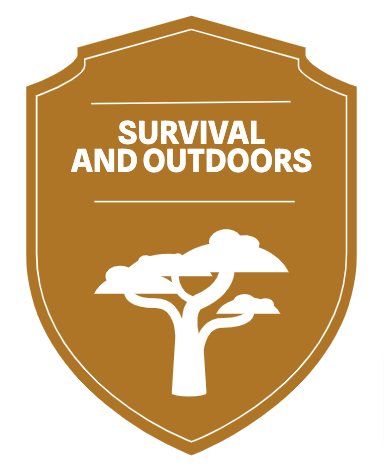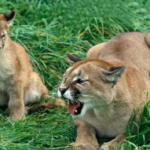Important Tips to protect yourself from Wild Animals in the Wilderness
This comprehensive guide draws from my decade of wilderness survival experience to help you stay safe during wildlife encounters. I know venturing into the wild can be exciting and intimidating, especially when considering potential animal confrontations. Whether you are hiking, camping, or exploring remote areas, understanding how to prevent and handle animal encounters is vital for your safety. In this guide, I'll share the proven strategies that have helped me avoid dangerous situations and survive close encounters with predators like bears, mountain lions, and wolves.
Key Takeaways:
- Maintain Distance and Awareness - Always keep at least 100 yards from large predators, scan your surroundings regularly, and make noise while hiking to avoid surprise encounters
- Proper Food Storage - Store food in bear-proof containers, cook 200 feet away from your campsite and never keep food inside your tent to prevent attracting wildlife
- Defense Tools and Techniques - Carry bear spray, know how to use it effectively, and learn animal-specific defense tactics like making yourself appear larger for mountain lions or backing away slowly from bears
When venturing into the wilderness, your safety depends on preparation and knowledge of wildlife behavior. Here's a comprehensive guide to protecting yourself:
List of Steps
Prevention Strategies:
Travel in groups of 3 or more - Make regular noise (clap, sing, or use bells) - Avoid hiking at dawn, dusk, or night - Stay on marked trails - Keep children close and supervised.
Animal-Specific Defense:
Bears: - Never run from a bear - Speak calmly but firmly - Back away slowly while facing the bear - Use bear spray if charged (aim slightly downward) - If attacked by a black bear - fight back - If attacked by a Grizzly Bear - play dead, protect your neck Mountain Lions: - Maintain eye contact - Stand tall and raise arms - Make loud noises - Fight aggressively if attacked - Protect throat and neck Wolves & Coyotes: - Stand your ground - Make yourself appear large - Use sticks or rocks as weapons - Never turn your back - Fight if necessary.
Essential Equipment:
Bear spray (within easy reach) - Whistle - Bright flashlight - First aid kit - Emergency communication device.
Camp Safety:
Set up camp in open areas - Create a triangle between sleeping, cooking, and food storage areas - Use bear-proof containers - never cook near your tent - Keep a clean campsite - and Store scented items (including toiletries) away from the sleeping area.
If Confronted:
Stay calm - Give the animal an escape route - Make yourself look bigger - Keep your group together - Make loud noises - Never play dead unless dealing with a grizzly bear attack These guidelines help minimize risk and increase survival chances during wildlife encounters. The best defense is always prevention through proper preparation and awareness of your surroundings.

Understanding Wildlife Behavior
For your safety in the wilderness, I recommend learning how to interpret animal behavior. Most wild animals won't attack unless they feel threatened. By understanding their patterns, territories, and seasonal behaviors, you can predict and avoid dangerous encounters. I've found that animals typically follow predictable routines around feeding, mating, and protecting their young.
Common Animal Encounters
Little do many hikers know that 90% of wildlife encounters can be prevented by making noise while walking and staying alert. I always tell my fellow hikers to watch for fresh tracks, droppings, and disturbed vegetation. You're most likely to encounter bears, mountain lions, wolves, or moose during dawn and dusk when they're actively hunting or feeding.
Warning Signs and Body Language
Signs of aggression in wild animals include direct eye contact, teeth-baring, growling, and hair-raising. I've learned that animals will often give you warning signals before attacking. You should look for defensive postures like lowered heads, pawing at the ground, or ears pinned back.
With years of wilderness experience, I can tell you that each species displays unique warning signs. Bears will make mock charges to test your reaction, while mountain lions may crouch and twitch their tails before pouncing. When you spot these behaviors, back away slowly while maintaining awareness of your surroundings. Your calm response can prevent an aggressive encounter from escalating into an attack.
Essential Safety Precautions
One of your primary concerns in the wilderness should be maintaining a safe distance from wildlife. I recommend you always carry bear spray, stay alert to your surroundings, and make noise while hiking to avoid surprising animals. You should never hike alone, and it's vital to learn about the specific wildlife in your destination area before your trip.
Campsite Selection and Setup
An ideal campsite location can significantly reduce your chances of wildlife encounters. I suggest setting up camp away from animal trails, water sources, and dense vegetation. You should establish a triangle layout with your sleeping area, cooking space, and food storage at least 100 yards apart. Creating noise barriers like hanging pots or bells around your campsite can provide early warnings of approaching animals.
Food Storage and Waste Management
Storage of food and waste requires strict adherence to safety protocols. You must keep all food, toiletries, and scented items in bear-resistant containers or hang them at least 10 feet high and 4 feet away from the tree trunk. I advise storing these items downwind and at least 100 yards from your sleeping area.
For instance, when I camp in Bear Country, I double-bag all food items and use airtight containers to minimize odors. You should never keep food in your tent, and it's crucial to clean up immediately after meals. I recommend using separate bags for food waste and packing out all trash. Even seemingly harmless items like fruit peels or coffee grounds can attract wildlife to your campsite.
Prevention Strategies
Your best defense against wild animal encounters starts with proper preparation. I recommend you maintain awareness of your surroundings, learn to identify animal tracks and signs and keep your campsite clean. You should store food in bear-resistant containers at least 100 yards from your sleeping area. Always carry deterrent sprays and know how to use them effectively.
Noise-Making Techniques
Noise-making is your primary tool to avoid surprise encounters. I suggest you clap your hands, sing, or use bear bells while hiking. You can attach bells to your backpack or use a whistle. These sounds give animals advance warning of your presence, allowing them to move away before you get too close. In dense vegetation or near running water, make extra noise.
Group Travel Guidelines
Assuming you're hiking in Bear Country, I advise traveling in groups of three or more. You should maintain a close formation but avoid bunching up too tightly. Keep children between adults and scan your surroundings regularly. Stay alert, particularly during dawn and dusk when animals are most active.
The effectiveness of group travel lies in numbers and organization. I've found that groups should maintain verbal communication and designate a leader and rear guard. You should keep gaps between hikers to less than 10 feet, making your group appear as one large entity to animals. This formation has proven to deter most predatory wildlife encounters.
Protective Equipment
Not having the right protective gear in the wilderness can put you at serious risk. I always recommend carrying a combination of defensive tools and safety equipment when venturing into areas with wild animals. Your preparation could mean the difference between a safe encounter and a life-threatening situation.
Bear Spray and Deterrents
With bear spray as your primary defense tool, you'll have a proven deterrent that works on multiple species. I suggest keeping it in an easily accessible holster on your belt or backpack strap. You should also carry air horns or whistles as additional deterrents, which can help scare away most predatory animals before a close encounter.
Safety Gear Essentials
Safety gear forms your basic defense line in the wilderness. I recommend carrying bright flashlights, emergency flares, and a reliable communication device. Your backpack should include protective clothing that covers exposed skin and sturdy boots to protect against encounters with smaller wildlife.
Essentials like a first-aid kit with pressure bandages, antibiotic ointment, and snake bite kits are non-negotiable items in your safety arsenal. I always pack backup batteries for all electronic devices, emergency shelters, and reflective materials to increase visibility. These items have helped me maintain safety during countless wilderness expeditions and could save my life in an emergency.
Emergency Response
Despite your best efforts to avoid wildlife encounters, I know that dangerous situations can still arise. You must stay calm and alert when facing a wild animal threat. I recommend keeping emergency contacts readily available, including local rangers and medical services. Your preparation should include carrying a reliable communication device and knowing your exact location to relay to rescuers if needed.
Encounter Protocols
For immediate safety during a wild animal encounter, I advise you to make yourself appear larger by raising your arms and speaking in a firm, loud voice. Your priority is to back away slowly while maintaining eye contact. Never run, as this can trigger a chase response. If you have bear spray, keep it ready and accessible. You should also ensure there's a clear escape route available.
First Aid Basics
Protocols for treating wildlife-inflicted injuries require immediate action. I emphasize the importance of controlling bleeding with direct pressure and clean bandages. Your first aid kit should be easily accessible, and you must clean any wounds thoroughly to prevent infection. Call for emergency assistance as soon as possible while managing the injury.
The basics of wilderness first aid include keeping the victim calm and warm while waiting for help. I recommend using sterile gauze for deep wounds and applying pressure bandages to stop bleeding. Your actions in the first few minutes are vital for survival. Monitor vital signs and document the time of injury and all first aid steps taken by medical professionals.
Region-Specific Guidelines
To stay safe in different environments, you need to adapt your protective measures. I recommend learning about the specific wildlife in your destination area before heading out. Your survival strategy should differ significantly whether you're hiking in bear country or exploring snake-inhabited deserts. The local ranger stations will provide you with the most up-to-date information about animal activity.
Mountain Safety Tips
To protect yourself in mountainous regions, follow these imperative guidelines:
- Carry bear spray and know how to use it
- Make noise by using bells or whistles
- Avoid hiking during dawn and dusk
- Store food in bear-proof containers
- Travel in groups of three or more
The most effective defense is staying alert and avoiding confrontation.
Forest Safety Measures
Forest environments require specific awareness due to dense vegetation and limited visibility. I always recommend maintaining a clear line of sight on trails and avoiding areas with fresh animal droppings. Your best defense is making your presence known through noise and staying on marked trails.
Plus, you should equip yourself with proper gear including sturdy boots and long pants. I've found that carrying a walking stick can serve both as a hiking aid and a defensive tool. Keep your food sealed in airtight containers and never approach or feed wildlife, no matter how harmless they may appear. Your campsite should be set up away from animal trails and water sources.
To wrap up
Hence, I recommend following these safety measures whenever you venture into wildlife territory. By staying alert, making noise while hiking, keeping your campsite clean, and carrying protective gear like bear spray, you'll minimize dangerous encounters. I've found that understanding animal behavior and respecting their space is your best defense. If you maintain proper food storage, travel in groups, and avoid hiking during dawn and dusk, you'll significantly reduce your risk. Trust your instincts – if you sense danger, calmly retreat using the techniques I've shared to ensure your wilderness experience remains safe and enjoyable.





